Security Council Resolutions and Selection Bias
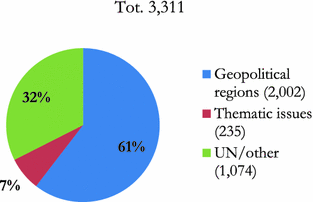
Fig. 5.1
Origins and cold war period (1946–1991)—aggregated data
The disaggregated data in the geopolitical section further demonstrates that 238 resolutions—comprising 42 %, concern the Middle East region while 146 resolutions—comprising 26 % of all SC decisions, concern the African continent. Taken together, the number of SC decisions addressing issues taking place in Africa and the Middle East is equal to 384 out of 557—comprising 68 % of SC resolutions on geopolitical regions. The figures do not take into consideration any decision addressing UN activities in those geopolitical areas (which have been classified as ‘UN/Other’ related issues), but only actions taken by the SC (see Table 5.1).
Table 5.1
Disaggregated data on composition of resolutions on geopolitical regions (1946–1991)
Geopolitical region | No. of resolutions |
|---|---|
Africa | 146 (26 %) |
Middle East | 238 (42 %) |
Europe | 97 (18 %) |
Other regions | 76 (14 %) |
Total | 557 (100 %) |
The composition of SC resolutions in the selected period of time suggests that, as long as the vast majority of resolutions address country-specific issues in two well-defined geopolitical areas, this could be interpreted as appearance of bias.
5.4 Post-cold War Period
In the period from 1992 to 2000, the SC adopted 608 resolutions. Grouped by categories of actions, the aggregated data shows that 75 % of resolutions address issues with a regional scope while 2 % of decisions address thematic issues. The remaining decisions—comprising 23 %, include actions previously agreed upon or taken by the broader family of UN institutions and seconded by the SC (see Fig. 5.2).
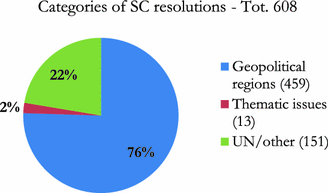

Fig. 5.2
Post-cold war period (1992–2000)—aggregated data
The disaggregated data in the geopolitical section further demonstrates that 180 resolutions—comprising 39 %, concern the African continent while 148 resolutions—comprising 32 % concern Europe. Furthermore, the results show that 77 resolutions—comprising 17 % of resolutions, concern the Middle East region. Taken together, the number of SC decisions addressing issues taking place in Africa and the Middle East is equal to 257 out of 459—comprising 56 % of SC resolutions on geopolitical regions. As in the figures for the cold war period, the computation does not take into consideration any decision addressing UN activities in those geopolitical areas (which have been classified as ‘UN/Other’ related issues), but only actions taken by the SC (see Table 5.2).
Table 5.2
Disaggregated data on composition of resolutions on geopolitical regions (1992–2000)
Geopolitical region | No. of resolutions |
|---|---|
Africa | 180 (39 %) |
Middle East | 77 (17 %) |
Europe | 148 (32 %) |
Other regions | 54 (12 %) |
Total | 459 (100 %) |
The analysis above shows that the composition of SC resolutions adopted during the post-cold war period is homogeneous to the one of the resolutions adopted during the cold war period. However, the total of resolutions on Africa and the Middle East adopted between 1992 and 2000 drops from 68 % in the cold war period to 56 % whereas the resolutions on Europe witness a rising of 14 %, from 18 % in the cold war period to 32 %. Within the disaggregated data, it is significant that the resolutions on the Middle East, which scored highest in this category during the cold war period, went significantly down in the same proportion as the increase of resolutions on Africa. This suggests that there is no open evidence of selection bias in the post-cold war period resolutions, a presumption that is corroborated by the limited similarity with the composition of resolutions on geopolitical regions adopted between 1946 and 1991.
5.5 The Twenty-First Century
In the period from 2001 to 2014, the SC adopted 861 resolutions. Grouped by categories of actions, the aggregated data shows that 81 % of resolutions address issues with a regional scope while 10 % of decisions address thematic issues. The remaining decisions—comprising 9 %, include actions previously agreed upon or taken by the broader family of UN institutions and seconded by the SC (see Fig. 5.3).
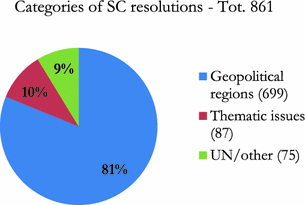

Fig. 5.3
The twenty-first century period (2001–2014)—aggregated data
The disaggregated data in the geopolitical section further demonstrates that 417 resolutions—comprising 60 %, concern the African continent while 154 resolutions—comprising 22 % concern the Middle East region. Taken together, the number of SC decisions addressing issues taking place in Africa and the Middle East is equal to 571 out of 699—comprising 82 % of SC resolutions on geopolitical regions. As in the analysis of previous periods period, the figures do not take into consideration any decision addressing UN activities in those geopolitical areas (which have been classified as ‘UN/Other’ related issues), but only actions taken by the SC (see Table 5.3).
Table 5.3
Disaggregated data on composition of resolutions on geopolitical regions (2001–2014)
Geopolitical region | No. of resolutions |
|---|---|
Africa | 417 (60 %) |
Middle East | 154 (22 %) |
Europe | 76 (11 %) |
Other regions | 52 (7 %) |
Total | 699 (100 %) |
The analysis above shows that in the period of time between 2001 and 2014 the proportion of categories of resolutions significantly changed compared with the previous period. In particular, whether the increase of the number of resolutions addressing country-specific issues is proportional to the higher number of resolutions adopted, thematic resolutions have risen fivefold while the number of resolutions authorizing or seconding UN activities is halved. Figure 5.4 shows the disaggregated data of the twenty-first century resolutions.
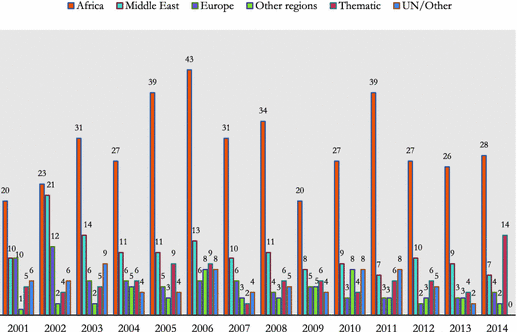

Fig. 5.4
Composition of resolutions (2001–2014)
The figures show that the number of resolutions adopted on Africa is equal to 48 % of all resolutions adopted between 2001 and 2014. Compared to the resolutions on the same subject-matter adopted in the previous two periods, it becomes apparent that the SC is devoting a substantial amount of attention to threats to international peace and security taking place in the African continent. The data in itself is not indicative of any behavioural pattern. However, it assumes a different weight when read in light of the corresponding figures in the previous periods of time: during the cold war period resolutions on Africa amounted to 26 % of the resolutions on geopolitical regions while during post-cold war period the figure went up to 39 %. The fact that in the twenty-first century has reached the peak of 60 % of resolutions on geopolitical regions signals a strong appearance of bias.
The presumption of bias can be tested against the composition of the other typologies of SC decisions adopted between 2001 and 2014, so long as resolutions represent only one quarter of all decisions taken.1
The disaggregated data on the entire spectrum of SC practice (2001–2014) show that the vast majority of decisions address issues on geopolitical regions, though in a significantly lower percentage compared to geopolitical resolutions (see Figs. 5.5 and 5.6). However, Table 5.4 shows that 58 % of decisions on country-specific or regional issues address situations taking place in Africa and the Middle East. The number nearly perfectly matches the percentage of resolutions adopted in the same period of time on the same subject-matter and this in turn suggests that the decisions adopted by the SC between 2001 and 2014 are tainted by selection bias.
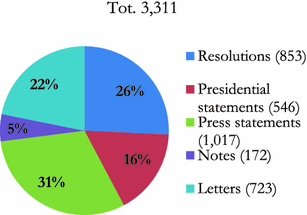


Fig. 5.5
Aggregated data on composition of resolutions (2001–2014)

Fig. 5.6
Categories of resolutions (2001–2014)